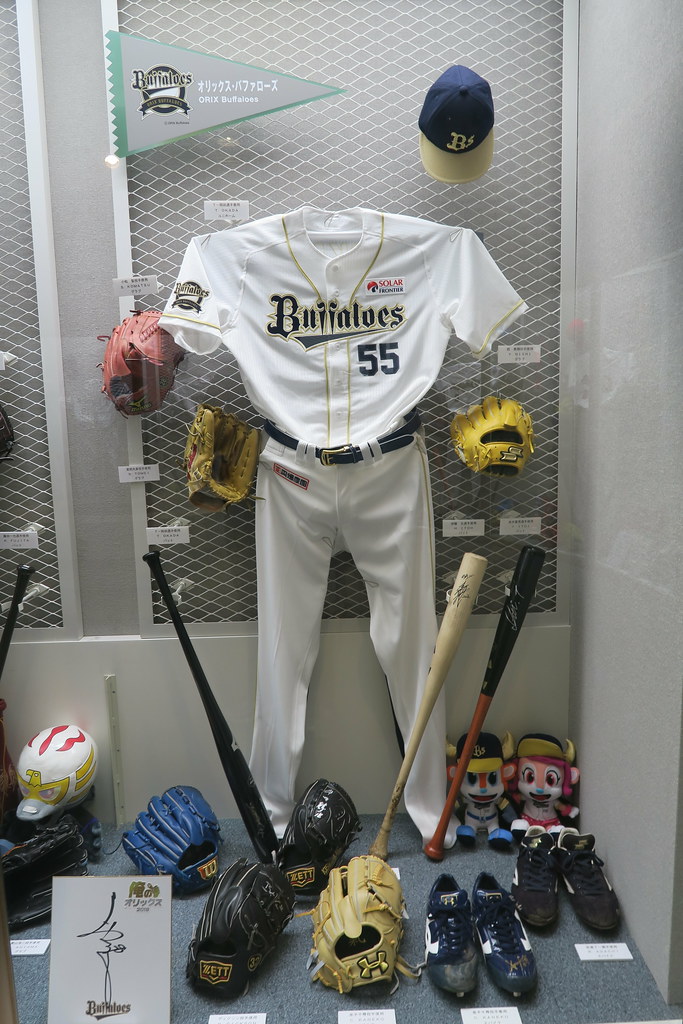
For tomorrow’s post, I will talk about the B-Wave – The ORIX Buffaloes Official Team Store in Kobe.
But for toda’s post, to segue into the store, I have to discuss the NPB (Nippon Professional Baseball) Pacific League ORIX Buffaloes first.
To know this current baseball team, you need to know two teams that preceded it.

Back in 1936, the Osaka Hankyu Baseball Club was in the ownership of a Japanese railway company known as the Hanshin Kyuko Railway Company. It would become known as the Hankyu Braves and was one of Japan’s first professional baseball teams.
The team was one of the most talented baseball teams in the mid-1960s but despite being the top team in the Pacific League and winning the pennant five times, the team did not win a Japan Series as the Yomiuri Giants would beat them each year.

Fortunately, the team would win the Japan Series three times in a row in the mid-’70s (1975-1977). By 1988, the Hankyu Railway sold the franchise to the lease company Orient Lease, who would change their name to the ORIX Group.

In 1991, the team moved to Kobe and became the ORIX BlueWave and the team was made popular in 1995 and 1996 when a young Ichiro Suzuki help the team win the pennant and win the Japan Series in 1996.
The Osaka Kintetsu Buffaloes was a team that was founded back in 1949.
The team would win the Pacific League title in 1979 & 1980 and make it into the Japan Series but would lose. The team is known for their superstar pitcher in the early ’90s, Hideo Nomo.
Unfortunately, the love between Nomo and management didn’t last long as the two didn’t meet eye to eye due to a contract dispute. Nomo wanted a contract agent and a multi-year contract, Kintetsu disagreed. And because they drafted him, they had exclusive rights to Nomo.
It’s important to know the Masanaro “Mashi” Murakami story, the first Japanese baseball player to play in the MLB and the last until 1995, when Nomo came to the Dodgers. This would show the challenges of MLB singing NPB players.
Anyway, Nomo’s agent Don Nomura found a loophole in the Japanese Uniform Players Contract. It happens that the “voluntary retirement clause” would allow a player who retired to play for whomever he wished after returning to active status. And thus, Nomo headed to the U.S., where the Los Angeles Dodgers signed him.
Nomo would become the first Japanese-born Major League player to relocate permanently to the American leagues.
The team is also known for their power hitter Tuffy Rhodes. In 2001, he hit his 55th homer to tie Sadaharu Oh’s Japanese League single season home run record set in 1964, but to prevent him from beating the record, opposing pitchers intentionally walked Rhodes to prevent him from breaking Oh’s record.

In 2004, the Kintetsu Buffaloes was sold to the ORIX Group, which owned the ORIX BlueWaves. ORIX announced that because the Kintetsu Buffaloes were not in great financial shape, that the Buffaloes and BlueWave would merge into one team called the Orix Buffaloes.
While the team retains the Buffaloes name from the original Kintetsu Buffaloes and uses the Kintetsu Buffaloes stadium – Kyocera Dome Osaka, the team has kept the blue and gold of the ORIX BlueWaves.
Of course, merging the two teams led to a big problem in the NPB between the two leagues and as part of the agreement, the Rakuten Golden Eagles were created to keep the six-team league structure and also lead to adopting interleague play.
Since it’s merger, the team has struggled but in 2008, they finished 2nd in the Pacific League and made it to the 1st stage of the Climax Series.
Still, fans hold hope for a better season for the ORIX Buffaloes.
As of May 16, 2018, the team is in fourth place in the rankings in the Pacific League and there is still a lot of baseball to be played.

In tomorrow’s post, I will go into the ORIX Buffaloes Official Team Store – B-Wave.
